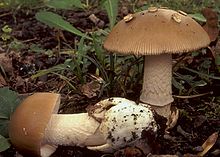
Amanita muscaria, commonly known as the fly agaric or fly amanita, is a basidiomycete of the genus Amanita. It is a large white-gilled, white-spotted, and usually red mushroom.

The genus Amanita contains about 600 species of agarics, including some of the most toxic known mushrooms found worldwide, as well as some well-regarded edible species. The genus is responsible for approximately 95% of fatalities resulting from mushroom poisoning, with the death cap accounting for about 50% on its own. The most potent toxin present in these mushrooms is α-Amanitin.

Amanita fulva, commonly called the tawny grisette or the orange-brown ringless amanita, is a basidiomycete mushroom of the genus Amanita. It is found frequently in deciduous and coniferous forests of Europe, and possibly North America.
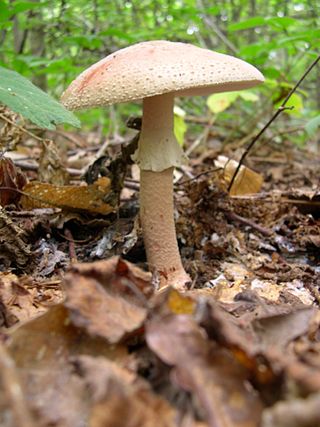
The blusher is the common name for several closely related species of the genus Amanita. A. rubescens, or the blushing amanita, is found in Europe and eastern North America, and A. novinupta, also known as the new bride blushing amanita, is found in western North America. Both their scientific and common names are derived from the propensity of their flesh to turn pink upon bruising or cutting.
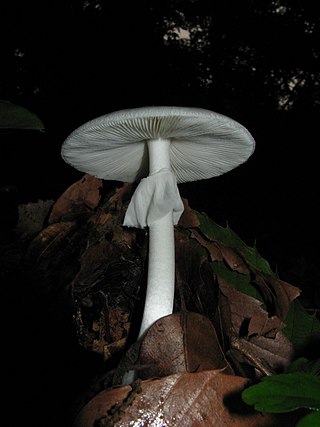
Amanita verna, commonly known as the fool's mushroom or the spring destroying angel, is a deadly poisonous basidiomycete fungus, one of many in the genus Amanita. Occurring in Europe in spring, A. verna associates with various deciduous and coniferous trees. The caps, stipes and gills are all white in colour.

Amanita bisporigera is a deadly poisonous species of fungus in the family Amanitaceae. It is commonly known as the eastern destroying angel amanita, the eastern North American destroying angel or just as the destroying angel, although the fungus shares this latter name with three other lethal white Amanita species, A. ocreata, A. verna and A. virosa. The mushroom has a smooth white cap that can reach up to 10 centimetres across and a stipe up to 14 cm tall with a white skirt-like ring near the top. The bulbous stipe base is covered with a membranous sac-like volva. The white gills are free from attachment to the stalk and crowded closely together. As the species name suggests, A. bisporigera typically bears two spores on the basidia, although this characteristic is not immutable. A. bisporigera closely resembles a few other white amanitas, including the equally deadly A. virosa and A. verna.
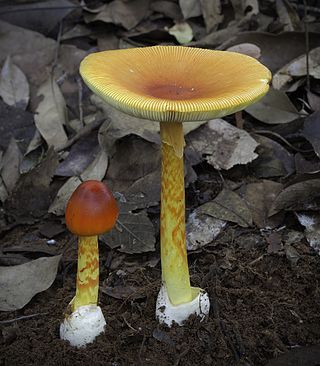
Amanita hemibapha, commonly known as the half-dyed slender Caesar, is a species of agaric found in southeast Asia and Oceania, although some distribution reports may refer to different taxa.

Amanita battarrae, also known as the grey-zoned ringless amanita, is a species of Amanita found in Italy in the fall as well as in eastern Europe.
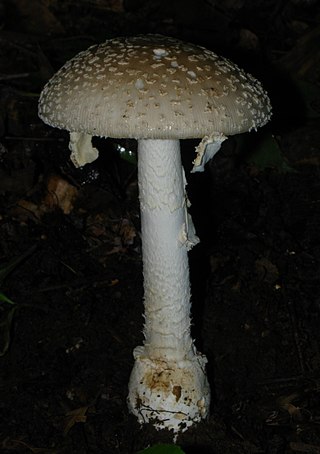
Amanita multisquamosa or the small funnel-veil amanita is a species of Amanita from the coniferous forest of eastern North America.

Amanita brunneolocularis, also known as the Mesoamerican dark volva blusher, is an uncommon species of Amanita.

Amanita curtipes is a species of Amanita from southern Europe.

Amanita proxima is a species of Amanita from France, Italy, and Spain. It is poisonous.

Amanita velatipes or veiled-bulb amanita is a species of Amanita from eastern North America.
Amanita pallidorosea is a deadly poisonous mushroom of the large genus Amanita, closely related to A. bisporiga. It occurs in China under beech trees.

Amanita solaniolens or old potato amanita is a species of Amanita from Nova Scotia, Canada.

Amanita elongata or Peck's yellow dust amanita is a species of Amanita from Northeastern United States and Canada.

Amanita polypyramis is a species of Amanita found in the Eastern United States. It is a large, bone white mushroom with a chlorine-like odor. Its species name, polypyramis, refers to the pyramid-like warts on the surface of the pileus (cap).

Amanita calyptratoides, or Peck's candlestick amanita, is a species of Amanita found in southern California

Amanita carneiphylla is a species of Amanita found in Western Australia growing among Eucalyptus, Banksia, and Allocasuarina
